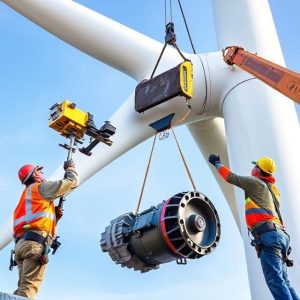
Wind energy accounted for 56% of Great Britain’s electricity production in 2024, marking a new high according to the BBC reporting on National Energy System Operator’s data.
Wind turbines are therefore a vital renewable energy source, but when a wind turbine goes offline, it’s not always because the entire system has failed. In many cases, it’s a single worn-out component that needs attention.
But replacing parts on a structure that towers around 100 metres into the sky—and often stands in the middle of a field or offshore site—comes with a unique set of challenges.
So, how does wind turbine component replacement actually work? Let’s take a quick look.
Condition Monitoring

Most turbines today are fitted with a range of high-tech sensors that constantly track things like vibration, temperature, oil levels, and rotor speed. If the sensors flag an issue, the system raises the alarm automatically, sending out an alert.
Early detection is crucial. The longer an emergent fault goes unaddressed, the greater the risk of secondary damage, downtime, or even a full replacement of major parts. That’s one of the main reasons why planned maintenance schedules and remote monitoring teams are so important.
On-site Assessment
If a fault is suspected, then an on-site assessment will be required. This part isn’t just about diagnosing the issue; it’s also about planning the logistics of getting it fixed.
Wind farms are often quite difficult to access, especially those in offshore locations, and the size and weight of components can require specialised equipment to get them to the location. A result, most maintenance will need to be done by a specialist provider such as AIS Wind Energy.
If a main bearing needs replacing, for example, you’ll need to use specialist equipment just to get that bearing up to the right place. That means coordinating cranes, transport vehicles, lift plans, and weather windows, all while complying with health and safety regulations. Combine that with offshore access, and it’s no mean feat getting it all done.
Replacement Process

The actual replacement follows a highly structured process, which may differ depending on the repair in question:
- Shutdown: The turbine will be powered down and isolated from the energy grid.
- Dismantling: The faulty component will be disconnected and carefully removed, often from a tight space. This may also require rope access technicians.
- Heavy lifting: Using specialist equipment, the old part is lowered and the new one lifted into place.
- Installation and testing: Engineers will fit the new component, run system checks, and test the turbine under controlled conditions before bringing it back online and connecting it to the energy grid.
This isn’t a quick job. A gearbox swap, for instance, might take a week from start to finish – longer if poor weather or difficult terrain slows progress.
Health and Safety
Every step of the replacement process is governed by strict health and safety protocols. Teams need rope access training, specialist PPE, and an in-depth understanding of the turbine model in question. Documentation, method statements, and lift plans are all part of the package.
Component replacement in the wind energy sector isn’t just about fixing faults – it’s about maintaining uptime, protecting investment, and extending asset life. It requires a careful blend of planning, expertise, and engineering muscle. And when it’s done right, it helps keep the blades turning and the power flowing.
![]()
Author Profile

- Eco Warrior by day, Eco Blogger by night trying to get the eco balance right.
Latest entries
 Green GuidesNovember 3, 2025The Beginner’s Guide to Making Your Own Nontoxic Candles at Home
Green GuidesNovember 3, 2025The Beginner’s Guide to Making Your Own Nontoxic Candles at Home Green Home GuidesOctober 14, 2025What are Eco-Friendly Tissue Options for Modern UK Homes?
Green Home GuidesOctober 14, 2025What are Eco-Friendly Tissue Options for Modern UK Homes? Best practicesSeptember 17, 20253 Ways Young Families Can Commit to Sustainable Living
Best practicesSeptember 17, 20253 Ways Young Families Can Commit to Sustainable Living EnvironmentSeptember 9, 2025Eco-friendly Gardening on a Budget: 6 Sustainable Choices that make a Difference
EnvironmentSeptember 9, 2025Eco-friendly Gardening on a Budget: 6 Sustainable Choices that make a Difference





Leave a Reply
You must be logged in to post a comment.